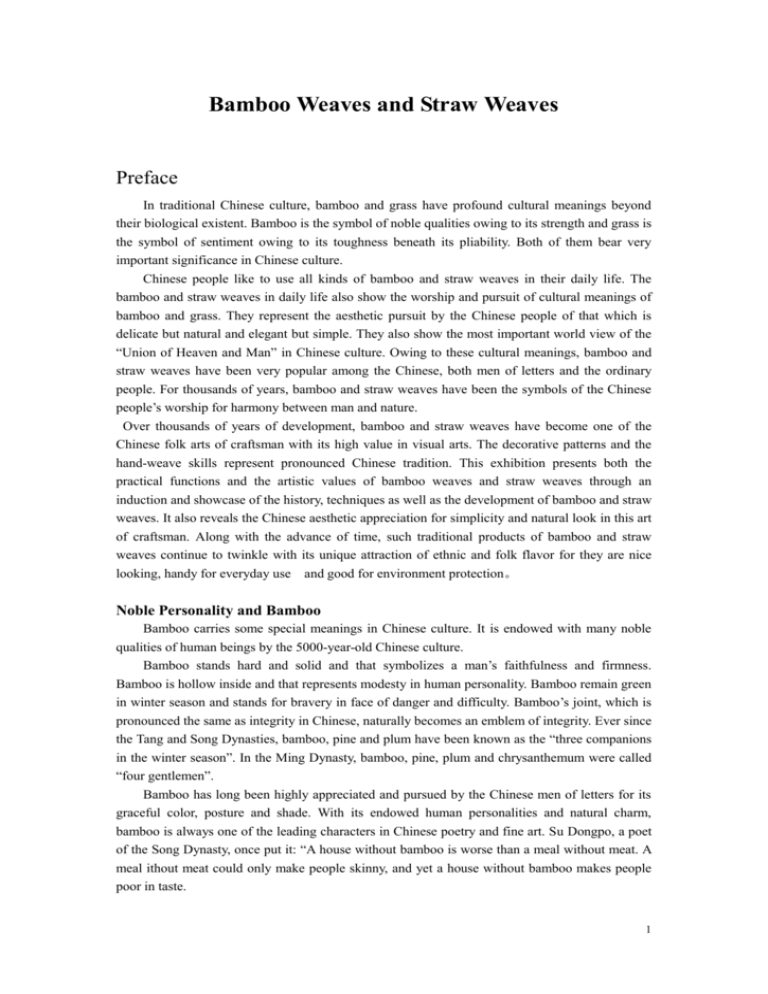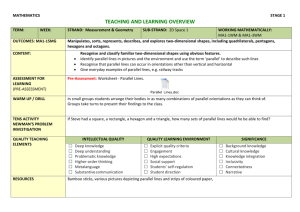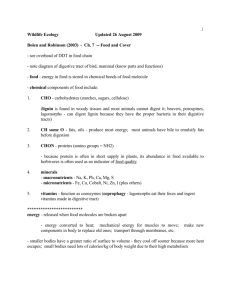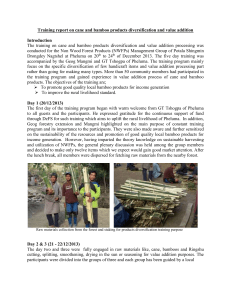Bamboo Weaves and Straw Weaves
advertisement

Bamboo Weaves and Straw Weaves Preface In traditional Chinese culture, bamboo and grass have profound cultural meanings beyond their biological existent. Bamboo is the symbol of noble qualities owing to its strength and grass is the symbol of sentiment owing to its toughness beneath its pliability. Both of them bear very important significance in Chinese culture. Chinese people like to use all kinds of bamboo and straw weaves in their daily life. The bamboo and straw weaves in daily life also show the worship and pursuit of cultural meanings of bamboo and grass. They represent the aesthetic pursuit by the Chinese people of that which is delicate but natural and elegant but simple. They also show the most important world view of the “Union of Heaven and Man” in Chinese culture. Owing to these cultural meanings, bamboo and straw weaves have been very popular among the Chinese, both men of letters and the ordinary people. For thousands of years, bamboo and straw weaves have been the symbols of the Chinese people’s worship for harmony between man and nature. Over thousands of years of development, bamboo and straw weaves have become one of the Chinese folk arts of craftsman with its high value in visual arts. The decorative patterns and the hand-weave skills represent pronounced Chinese tradition. This exhibition presents both the practical functions and the artistic values of bamboo weaves and straw weaves through an induction and showcase of the history, techniques as well as the development of bamboo and straw weaves. It also reveals the Chinese aesthetic appreciation for simplicity and natural look in this art of craftsman. Along with the advance of time, such traditional products of bamboo and straw weaves continue to twinkle with its unique attraction of ethnic and folk flavor for they are nice looking, handy for everyday use and good for environment protection。 Noble Personality and Bamboo Bamboo carries some special meanings in Chinese culture. It is endowed with many noble qualities of human beings by the 5000-year-old Chinese culture. Bamboo stands hard and solid and that symbolizes a man’s faithfulness and firmness. Bamboo is hollow inside and that represents modesty in human personality. Bamboo remain green in winter season and stands for bravery in face of danger and difficulty. Bamboo’s joint, which is pronounced the same as integrity in Chinese, naturally becomes an emblem of integrity. Ever since the Tang and Song Dynasties, bamboo, pine and plum have been known as the “three companions in the winter season”. In the Ming Dynasty, bamboo, pine, plum and chrysanthemum were called “four gentlemen”. Bamboo has long been highly appreciated and pursued by the Chinese men of letters for its graceful color, posture and shade. With its endowed human personalities and natural charm, bamboo is always one of the leading characters in Chinese poetry and fine art. Su Dongpo, a poet of the Song Dynasty, once put it: “A house without bamboo is worse than a meal without meat. A meal ithout meat could only make people skinny, and yet a house without bamboo makes people poor in taste. 1 Bamboo has long been a symbol of gentlemen in Chinese culture. Sentimental Feelings and Grass Grass also bears very important significance in the traditional Chinese culture. In the eyes of Chinese men of letters, grass always means farewell and memory. Grass insight is the same as the grass else where in mind. Therefore, grass often makes people think of friends and the loved ones faraway. To those ancient Chinese poets, grass stands for typical emblem of sad feelings at departure times. Grass comes even closer to ordinary people in their daily life. People from the bottom of society are still referred to as the grassroot class today. Common people see the great vitality of grass and the tough but pliable grass has become the symbol of people’s strong will. Poems like “In Strong wind reveals the tenaciousness of the grass” and “In spring breeze the grass come back to life again” all admire the great vitality of grass and have become common idioms. Bamboo Weaves and Straw Weaves China boasts the greatest varieties of living bamboo with more than 30 classes and 500 different breeds of bamboo growing in the country, even more so with the grass in China. Like stalks and stems of other plants, the pliable fiber split from bamboo could be cut into strips as raw materials to weave different kinds of daily utensils and handicrafts. In the Paleolithic Period, people started to weave nets with pliable materials such as straw or bark .Stone balls could be put in the nets and then thrown out for hunting. Before the creation of written characters, ancient people in many places made records by tying knots on the rope. Those straw nets and straw ropes are the origins of straw weaves. They showed how the primitive people made use of the nature under the extremely poor conditions. They also howed the wisdom of mankind. Long History of Bamboo Weaves and Straw Weaves Chinese bamboo weaves and straw weaves have a very long history. The history of bamboo weaves can be traced back to the Liangzhu Culture in the Neolithic Age (starting around 6000 BC). Many relics of bamboo weaves were found in the Liangzhu site. The exquisiteness of the weaving skills showed that bamboo weaves were widely used by people at the time. In the more than 7000-year-old Hemudu cultural site, hundreds of relics of straw mats were found. From those oldest relics of straw weaves found in China, we can see that the weaving skills at that time were almost as same as those today. The long history of bamboo weaves and straw weaves found in the sites showed that the ancient Chinese people not only knew nature well but knew how to improve their lives by making use of nature. Development of Bamboo Weaves and Straw Weaves Straw weaves were widely used in the Qin and Han dynasties. According to Liji, the Book of Rites, there were straw mat and professional weavers in the Zhou Dynasty. In Spring and Autumn Period and the Warring States Period, people started to make hats with day lily and cattail. In the Tang Dynasty, straw weaving was so highly developed that there even were sails woven from cattail. Bamboo weaving also has a long history. In the Tang and Song dynasties, bamboo weaves were very popular. We can still find bamboo weaves made in the Ming and Qing dynasties. Even the bowls, cups, plates and bottles for daily use also showed the natural and poetic life of ancient 2 people. Most of the bamboo and straw weaves made use of the natural color of bamboo and grass. They were simple but elegent and have made great improvements during their long history of development. Cultural Meanings of Bamboo Weaves and Straw Weaves In Chinese culture, some special bamboo weaves and straw weaves have special meanings recognized by the whole nation. Before paper was invented, people cut or wrote characters on bamboo slips and strung the slips together. Chinese people called history “Green History”, which refers the history recorded on green bamboo slips. Thatched Cottages and Bamboo Fences In ancient time, both bamboo and grass were important construction materials. Often bamboo was used to make fences and straw to build cottages. Bamboo cottages, bamboo fences and bamboo plantation around houses were very common in ancient China partly because of the Chinese people’s worship of bamboo culture, and also for the reason that bamboo grows fast, and endurable as construction material. The bamboo fences, in particular, see-through and simple in structure, are actually open and more symbolic as walls, revealed the mutual trust and closeness among people in ancient China. Some nature loving high-class officials at that time also enjoyed ordinary civilian residences such as thatched cottages with bamboo fences. Many men of letters prefered to live in their thatched cottages with bamboo fence so as to stay close to nature and away from vanity. All Forms of Bamboo Weaves Bamboo was used in all aspects of life in ancient China. The chopsticks people used every day were made from bamboo. They were light, strong, and easy to obtain, cheap and could reduce the consumption of wood. Musical instruments were called “silk and bamboo” in ancient China because many important Chinese traditional musical instruments like the Sheng, Guan, flute and Xiao were all made from bamboo. Chinese medicines like Zhuhuang and Zhuru are also produced out of different parts of bamboo and are very effective in some cases. Meanwhile, handicrafts made from bamboo roots and shoots have also been well developed in China. Colorful Straw Weaves Straw weaves were the product of agricultural civilization and result of farmers’ use of natural materials in their spare time. Apart from all kinds of grass, stalks like corn leaves and straws are also important materials for straw weaving. Different areas in China have their unique straw weaves. Even today, straw mats are household necessities in summer. Straw mats of high quality can stand still when put up are waterproof and last for more than twenty years. Most of straw weaves keep the simple nature of grass no matter whether they are dyed or not, or whether or not they are decorated with patterns. With the passing of time, more kinds of straw weaves appear. All straw-woven toys and handicrafts made from high skills are the product of a rich imagination. They are colorful, interesting, and real. They are a part of traditional folk toys 3 and the source of people’s spare time entertainment. Living with Bamboo Qingshen in Sichuan Province, Ji’an in Zhejiang Province, Ningguo in Anhui Province and regions where the Dai ethnic group lives in Yunnan Province are known as the home of bamboo weaves. Some local bamboo weaves are highly decorative. The Dai people in Xishuangbanna region use bamboo weaves for all daily necessities. Even their traditional cottages were made from bamboo. Most of the Dai people’s bamboo cottages are square and two-storied. All the pillars, roof beams, doors and walls are made of bamboo and the floor are also made from bamboo strips. The Dai people also like to plant bamboo around their houses, and bamboo is in every aspect of their lives. There are also many people in other places just like the Dai people, who prefer to live in such a natural manner. Dressed with Grass In the past, the most wildly used straw weaves were different kinds of straw sandals which first appeared in the Xia Dynasty and popular even among nobles in the Spring and Autumn Period. The waterproof palm-bark rain cape was made from palm bark and palm leaves. It was said that Emperor Yao was enthroned in a palm-bark rain cape. The bamboo hat and straw-woven rain cape have become the symbol of an idyllic life. The straw hat is soft and can block sunlight and rain-drops. Straw hats today are rich in color and lovely in designs. They are fashionable and loved by people. The different kinds of straw-woven hats and dresses are not only cheap but also bring an idyllic flavour to the people wearing them. Clever Mind and Skillful Hands Both of bamboo weaves and straw weaves must be made by skillful hands. As one of the oldest weaving skills, straw weaving has developed into dozens of ways of weaving from the basic skill of tying knots together. It is very popular among people because of the simplicity and richness of the materials. Bamboo weaving is very strict in terms of the choosing of the bamboo. Different products must be made of bamboo in different growing period. Through many complicated working procedures, bamboo was cut into different kinds of strips and pieces and then woven into different patterns. A piece of bamboo joint could be cut into more than twenty pieces and each piece has its own usage. Bamboo weaves could be kept for hundreds of years when sealed airtight. From Practical Use to Aesthetic Function Bamboo weaves are the artistic reproduction of bamboo and they have both practical functions and artistic meaning. It was said that Wang Fu, the wife of Su Dongpo, the great poet and writer of the Song Dynasty, made a bamboo fan for him and it soon became popular. The art of bamboo-woven fans has been developed from then on and many kinds of complicated patterns were invented. With the enhancing of the aesthetic function for those common bamboo weaves as fans, the craftsmen were required to have skillful hands and clever minds at the same time. With bamboo weaves, daily life will become idyllic and full of artistic taste and Chinese people’s ideal for the harmony between men and nature will also be shown. 4 Integration of Different Forms of Art China roughcast bamboo weaves were first invented in the Qing Dynasty. By weaving bamboo wires that as thin as hair and as soft as silk outside of a China roughcast, bamboo and China became an integral whole. Choosing of the material for this kind of handicraft is very strict. Among hundreds of kinds of bamboo, only Cizhu could be used and only 400 grams of bamboo wire could be made from every 50 kilograms of Cizhu. These bamboo wires are as valuable as silver. China roughcast bamboo weaves are of high artistic value. It integrates the art of bamboo weaving, China, carving, painting and mosaic. It is the result of the integration of many kinds of traditional Chinese folk arts. Skills and Arts The aesthetic element in modern Chinese bamboo weaves has been increasingly strengthened. With superb skills and elegant taste, the craftsmen nowadays have made bamboo weaves a part of Chinese bamboo culture and elegent culture. The materials for bamboo-weave pictures must be chosen carefully. Only bamboo joints longer than 80 centimeters could be used. The joint was cut into wires as thin as hair and the wires would be woven according to famous paintings. Bamboo-weave pictures have the same drawing technique as the original paintings and have the character of the art of bamboo weaving. They are as delicate as silk and embroidery。 The Development of Tradition Bamboo weaving and straw weaving are popular in many parts of China. Bamboo weaving is more popular in South China and straw weaving is popular in the whole country. One may find that everyone is busy weaving by the end of the year when they do not need to farm. The skills of bamboo and straw weaving have been passed from generation to generation. There are also many workshops. With the development of time and the needs of the market, there are more and more factories besides those workshops. The techniques of bamboo and straw weaving have also been improved greatly. In recent years, more attention has been paid on the artistic aspect of bamboo and straw weaving. New skills were combined with traditional ones. New ideas were put into the designs. Integrating the beauty of ancient and modern, bamboo weaves and straw weaves have become more expressive. New Fashions of Tradition With the change of materials in industrial modernlization, straw weaves declined for a time. However, bamboo weaves and straw weaves are being welcomed by more and more people in today’s China owing to their natural color and simple designs. Bamboo weaves and straw weaves today have combined practical use and aesthetic functions, with many new products appearing, such as garderobes, screens, carpet, lampshapes, wallpaper, etc. Fashionable designs were added to traditional skills. The rejuvenation of bamboo weaves and straw weaves today shows that people are rethinking their attitudes towards to nature and life. They bring either a flavour of history or a fresh air to people’s homes and give space for people to rest. 5 Return to Green Materials The popularity of bamboo weaves and straw weaves today also showed Chinese people’s desire to go back to nature. Until the beginning of 80s of last century, Chinese people had the tradition to take bamboo baskets to market. Bamboo baskets were a daily necessity to most Chinese families. In recent years, there has been a new fashion to refuse to use plastic bags and take bamboo baskets again in Wenzhou, Shanghai and many other places in China. Bamboo baskets and many other bamboo and straw weaves have come back to Chinese people’s life because of their environmentally friendly characteristics. With nature becoming the dream of those people living in cities, holding a bamboo basket is a way of returning to this. Summary Bamboo weaves and straw weaves come from nature and benefit from nature. They are delicate and inexpensive and have been loved by people for all the time. After their development for a long time, bamboo and straw weaves have been a part of people’s lives. Traditional craftsmen also weaved their feelings of life into their works and passed it from generation to generation. Bamboo weaves and straw weaves, which hold history and tradition within them, will be developed further in the hands of creative Chinese people and bring happiness and harmony to people. 6







